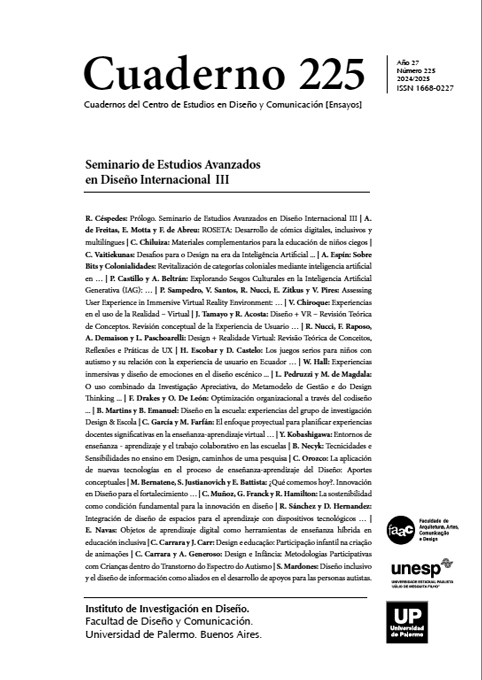Objetos de aprendizaje digital como herramientas de enseñanza híbrida en educación inclusiva
Resumen
El presente estudio, centrado en la integración de objetos de aprendizaje digital en la enseñanza híbrida para facilitar la educación inclusiva, emplea un método de revisión bibliográfica para analizar una variedad de fuentes académicas.
Citas
Billings, D. M. (2010). Using Reusable Learning Objects. The Journal of Continuing Education in Nursing, 41(2), 54–55. https://doi.org/10.3928/00220124-20100126-08
Cavanaugh, C., Freidhoff, J., & Ferdig, R. (2012). Lessons learned from blended programs: Experiences and recommendations from the field. iNACOL
Cortiella, C. (2016). The state of learning disabilities (Third, Issue October). National Center for Learning Disabilities.
Chen, B. H., & Chiou, H.-H. (2014). Learning style, sense of community and learning effectiveness in hybrid learning environment. Interactive Learning Environments, 22(4), 485–496. https://doi.org/10.1080/10494820.2012.680971
Cheung, S. K. S., Kwok, L., Yang, H., Fong, J., & Kwan, R. (2015). Hybrid Learning: Innovation in Educational Practices (Vol. 9167). Springer International Publishing. https://doi.org/10.1007/978-3-319-20621-9
Dodani, M. H. (2002). The Dark Side of Object Learning: Learning Objects. The Journal of Object Technology, 1(5), 37. https://doi.org/10.5381/jot.2002.1. 5.c3
Engzell, P., Frey, A., & Verhagen, M. D. (2021). Learning loss due to school closures during the COVID-19 pandemic. Proceedings of the National Academy of Sciences, 118(17). https://doi.org/10.1073/pnas.2022376118
Franklin, D. (2018). Helping your child with language-based learning disabilities: Strategies to succeed in school & life with dyslexia, dysgraphia, dyscalculia, ADHD & processing disorders. New Harbinger Publications.
Ferri, F., Grifoni, P., & Guzzo, T. (2020). Online learning and emergency remote teaching: Opportunities and challenges in emergency situations. Societies, 10(4). https://doi.org/10.3390/soc10040086
Grigorenko, E. L., Compton, D. L., Fuchs, L. S., Wagner, R. K., Willcutt, E. G., & Fletcher, J. M. (2020). Understanding, educating, and supporting children with specific learning disabilities: 50 years of science and practice. American Psychologist, 75(1), 37–51. https://doi.org/10.1037/amp0000452
Guenaga, M., Mechaca, I., Romero, S., & Eguíluz, A. (2012). A tool to evaluate the level of inclusion of digital learning objects. Procedia Computer Science, 14, 148–154. https://doi.org/10.1016/j.procs.2012.10.017
Hartono, S., Kosala, R., Supangkat, S. H., & Ranti, B. (2018). Smart Hybrid Learning Framework Based on Three-Layer Architecture to Bolster Up Education 4.0. 2018 International Conference on ICT for Smart Society (ICISS), 1–5. https://doi.org/10.1109/ICTSS.2018.8550028
Helms, S. A. (2014). Blended/hybrid courses: a review of the literature and recommendations for instructional designers and educators. Interactive Learning Environments, 22(6), 804–810. https://doi.org/10.1080/10494820.2012.745420
Hwang, A. (2018). Online and Hybrid Learning. Journal of Management Education, 42(4), 557–563. https://doi.org/10.1177/1052562918777550
Kalogiannakis, M., & Papadakis, S. (2017). Combining mobile technologies in environmental education: a Greek case study. International Journal of Mobile Learning and Organisation, 11(2), 108. https://doi.org/10.1504/IJMLO.2017.084272
Li, Q., Li, Z., & Han, J. (2021). A hybrid learning pedagogy for surmounting the challenges of the COVID-19 pandemic in the performing arts education. Education and Information Technologies, 26(6), 7635–7655. https://doi.org/10.1007/s10639-021-10612-1
Mettis, K., & Väljataga, T. (2021). Designing learning experiences for outdoor hybrid learning spaces. British Journal of Educational Technology, 52(1), 498–513. https://doi.org/10.1111/bjet.13034
Mooij, T. (2007). Design of educational and ICT conditions to integrate differences in learning: Contextual learning theory and a first transformation step in early education. Computers in Human Behavior, 23(3), 1499–1530. https://doi.org/10.1016/j.chb.2005.07.004
Norman, S., & Porter, D. (2007). Designing Learning Objects for online learning. Vancouver, BC,Canada: Knowledge Series.
Papastergiou, M., & Mastrogiannis, I. (2021). Design, development and evaluation of open interactive learning objects for secondary school physical education. Education and Information Technologies, 26(3), 2981–3007. https://doi.org/10.1007/s10639-020-10390-2
Poultsakis, S., Papadakis, S., Kalogiannakis, M., & Psycharis, S. (2021). The management of Digital Learning Objects of Natural Sciences and Digital Experiment Simulation Tools by teachers. Advances in Mobile Learning Educational Research, 1(2), 58–71. https://doi.org/10.25082/AMLER.2021.02.002
Prasetiyo, W. H., Ishak, N. A., Basit, A., Dewantara, J. A., Hidayat, O. T., Casmana, A. R., & Muhibbin, A. (2020). Caring for the environment in an inclusive school: The Adiwiyata Green School program in Indonesia. Issues in Educational Research, 30(3).
Redfors, A., Hansson, L., Kyza, E. A., Nicolaidou, I., Asher, I., Tabak, I., Papadouris, N., & Avraam, C. (2014). CoReflect: Web-Based Inquiry Learning Environments on Socioscientific Issues (pp. 553–566). https://doi.org/10.1007/978-94-007-7281-6_34
Redmond, C., Davies, C., Cornally, D., Adam, E., Daly, O., Fegan, M., & O’Toole, M. (2018). Using reusable learning objects (RLOs) in wound care education: Undergraduate student nurse’s evaluation of their learning gain. Nurse Education Today, 60, 3–10. https://doi.org/10.1016/j.nedt.2017.09.014
Sanchez-Muñoz, R., Carrió, M., Rodríguez, G., Pérez, N., & Moyano, E. (2022). A hybrid strategy to develop real-life competences combining flipped classroom, jigsaw method and project-based learning. Journal of Biological Education, 56(5), 540–551. https://doi.org/10.1080/00219266.2020.1858928
Sinclair, J., Joy, M., Yau, J. Y.-K., & Hagan, S. (2013). A Practice-Oriented Review of Learning Objects. IEEE Transactions on Learning Technologies, 6(2), 177–192. https://doi. org/10.1109/TLT.2013.6
Sotirova, E.-M. (2020). PRIMARY SCHOOL TEACHER’S PRACTICES AND STUDENT’S MENTAL REPRESENTATIONS: THE LEARNING OBJECTS OPTION. European Journal of Open Education and E-Learning Studies, 5(2). https://doi.org/10.46827/ejoe.v5i2.3327
Swanson, H. L. (2000). Issues Facing the Field of Learning Disabilities. Learning DisabilityQuarterly, 23(1),37–50. https://doi.org/10.2307/1511098
Thomas, M. S. C., & Rogers, C. (2020). Education, the science of learning, and the COVID-19 crisis. PROSPECTS, 49(1–2), 87–90. https://doi.org/10.1007/ s11125-020-09468-z
Van Assche, F., & Vuorikari, R. (2006). A framework for quality of learning resources. In Handbook on Quality and Standardisation in E-Learning (pp. 443–456). Springer Berlin Heidelberg. https://doi.org/10.1007/3-540- 32788-6_29
Vlachopoulos, D. (2011). COVID-19: Threat or Opportunity for Online Education? Higher Learning Research Communications, 10(1). https://doi.org/10.18870/hlrc.v10i1.1179
Los autores/as que publiquen en esta revista ceden los derechos de autor y de publicación a "Cuadernos del Centro de Estudios de Diseño y Comunicación", Aceptando el registro de su trabajo bajo una licencia de atribución de Creative Commons, que permite a terceros utilizar lo publicado siempre que de el crédito pertinente a los autores y a esta revista.


